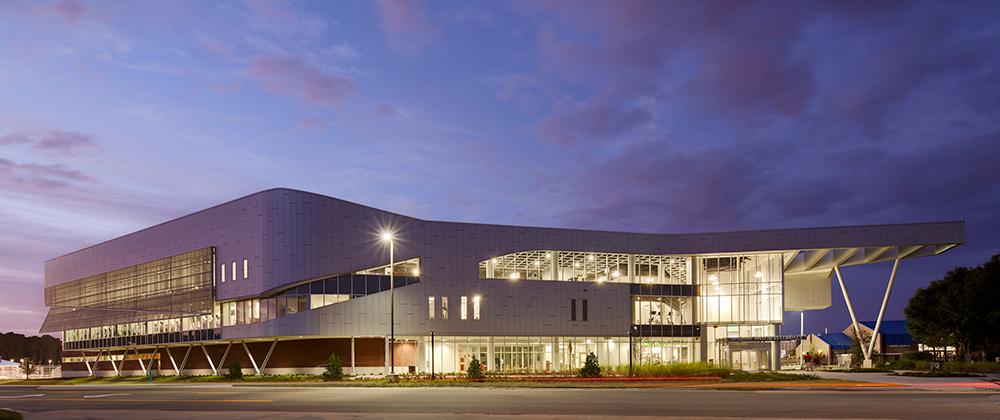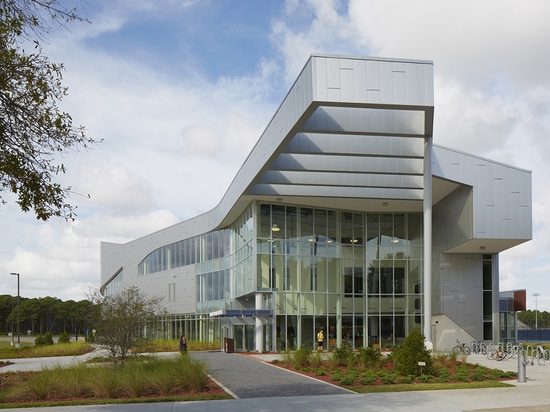
#PUBLIC ARCHITECTURE PROJECTS
UNF Student Wellness Complex
Geographically Florida is defined as a peninsula and a panhandle. Jacksonville sits in the northeast corner of the state, at the confluence of these two conditions. One result of this location is what architect Christopher Frye describes as eclectic buildings that are rooted in their place. Mr. Frye answered a few questions about the two-phase project
What were the circumstances of receiving the commission for this project?
The project was acquired in response to an RFP. Four to five teams were interviewed for the project over the course of 2 days. PSA-Dewberry in a joint venture with Borrelli & Partners won the commission.
Can you describe your design process for the building?
The vision for the project went through a few iterations prior to coming into focus. There was an existing, 9,700-sf building that housed the student recreation center for the University. The initial brief was to add on to that existing center in phases, with the final phase demolishing the existing facility. In evaluating the costs and schedules to develop this 4-phase construction process, the University elected to consolidate it into a 2-phase project. The components were re-prioritized to fit the overall project budget resulting in the first phase as completed. The second phase will include the addition of a gymnasium, track extension, and physical education spaces.
How does the completed building compare to the project as designed? Were there any dramatic changes between the two and/or lessons learned during construction?
Overall the project maintained the genesis of the original ideas and intent. The largest change between the initial concept and the final outcome dealt with the change of the exterior material due to budget considerations. The original exterior was to be clad in a cement fiber rain screen panel with a stainless steel expanded metal mesh for the large sunscreen. Both materials were changed to other metal panel systems during the bidding process.
How does the building compare to other projects in your office, be it the same or other building types?
The UNF Student Wellness Complex is one of two projects that were being designed simultaneously with similar programs and initial requirements. The Illinois Central College Cougarplex was a smaller building design, with similar constraints. Both required additions to existing facilities. The ICC project took elements of UNF and reinterpreted details as well as extended further into notions of sustainability thru the use of natural light, green roofs, etc. The UNF facility was one of several student recreation centers completed over the last 5+ years which were led by Christopher Frye.
How does the building relate to contemporary architectural trends, be it sustainability, technology, etc.?
The University directed the team to obtain a LEED Silver rating for the facility. As a common practice, buildings we design constantly consider opportunities for sustainability, the use of new materials, and methods of construction which use enhanced digital fabrication techniques. All of these considerations have become almost standard practice within the industry and at the forefront during the design of UNF. Currently the project has been submitted as LEED Gold, surpassing the initial expectations of the client.
Are there any new/upcoming projects in your office that this building’s design and construction has influenced?
Each one of our projects is a response to a particular project’s needs. We are deliberate in our actions and our aspirations throughout the design process, engaging in a continuous discourse with clients and consultants, uncovering opportunities that are triggered by various events or circumstances. We expand on the “What if…?” scenarios which inform solutions that go beyond the physical buildings. The many drawings and models that are produced throughout the process take into account tested planning methodologies, ideas derived from the discourse and project needs, as well as the envisioned internal and external human experience. Our process is collaborative and inclusive of all factors influential to the outcome of the work, including: programmatic, contextual, environmental, political, social, economic, and cultural…all influencing the augmentation of the work, creating holistic solutions.
How would you describe the architecture of Florida and how does the building relate to it?
Florida’s architecture is diverse. As one moves from the north to the south one locates most of the highly publicized and identifiable architecture in and around the Miami area.
In the northern vicinity of Florida, the architecture is rooted more in its specific place, becoming more eclectic depending on its context. At UNF, the campus has embraced a new direction for its architecture which could be defined as being a bit of a modern/brutalist approach. Much of this direction is a direct response to controlling the harsh Florida sun by creating more mass, less fenestration. With new technologies in glass and shading strategies, more buildings on the campus have been developed to take advantage of the views into the neighboring landscape, allowing for a more inside/outside reading.





